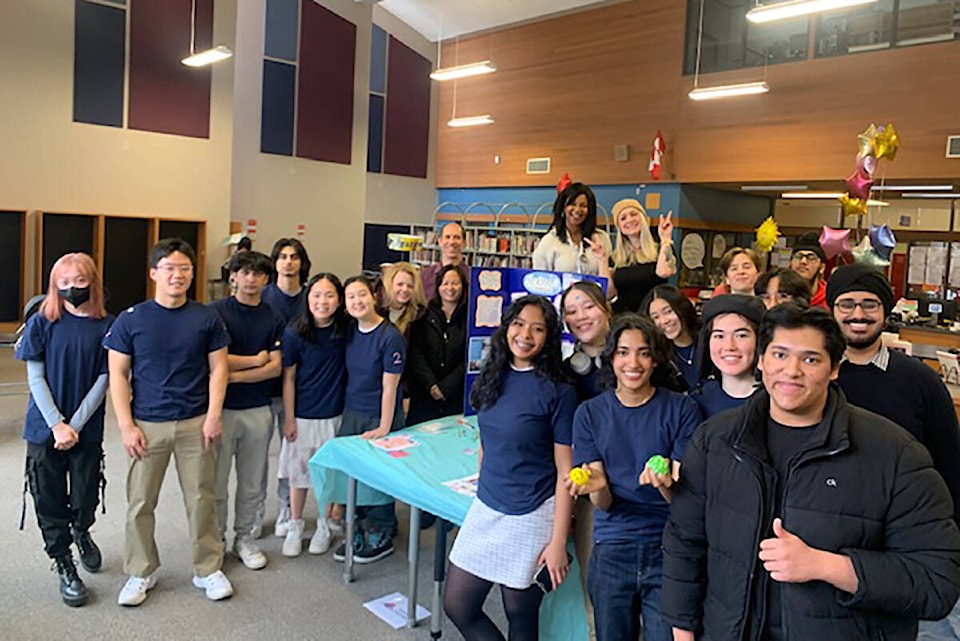A group of Semiahmoo Secondary students from South Surrey have brought back Mental Health Day to their school, breathing new life into an event that had been on hold since the start of the pandemic.
Working together with school counsellors, six students organized this yearтАЩs event, which took place Tuesday, Feb. 28 in the library during the lunch hour. The entire school was invited to participate.
Displayed throughout the room were informative posters. There were areas designated for participants to de-stress by playing games or painting. Counsellors and non-profit organizations shared techniques to handle stress and anxiety, including breathing exercises and more.
тАЬMental (illness) is a very relevant and ongoing issue that goes under-addressed in multiple settings, including schools where most of us spend (a lot) of time throughout the week,тАЭ said Catherine Jiang, a Grade 12 student at Semiahmoo who co-organized the event.
In order to make the day a reality, the students researched youth mental health to find ways to тАЬembody different ways of practicing healthy self-care practices and also just shining a light on the necessity of taking care of your well-being.тАЭ
Bringing Mental Health Day back to the school was important for Jiang and her team, who said resources for people their age are not easy to access. Having school counsellors is great, she added, but enhancing services could benefit more students.
тАЬBefore diving into this project, I didnтАЩt really have too much contact with mental health (services) because it isnтАЩt something that we really bring up often.
тАЬStudents are under high pressure, whether thatтАЩs academically or trying to juggle school, social and family life. I think thatтАЩs not spoken (about) enough.тАЭ
The event drew large numbers of students, with the library тАЬpackedтАЭ for most of the event.
Early start crucial
тАЬWhen schools do days, like Mental Health Day, thatтАЩs great, but itтАЩs not sustainable,тАЭ said Andrew Baxter, a registered social worker who works with the provinceтАЩs educators through the University of British ColumbiaтАЩs faculty of education mental health institute.
тАЬHow do we have this sustained in the school community or school culture? The way to do that is to change school classroom practices. Our belief is that if you put this right next to math, if you build this into curriculumтАж then that really reduces the stigmaтАж you open pathways to care, you improve help-seeking and it normalizes it for youth.тАЭ
Onset of about 70 per cent of mental illnesses happens between the ages of 12 and 25, but education about mental health should begin earlier than that, Baxter added. He has trained educators in most school districts in B.C. to recognize when students may be struggling and refer them to services that can provide appropriate next steps for that student.
Some students require more community support for the issues they face, while others need psychiatric care or тАЬa higher level of service,тАЭ Baxter said, adding that differentiating between the two is the job of trained professionals and should not be put on educators.
How the pandemic has affected youthsтАЩ mental health is still not completely known, Baxter said.
тАЬSome of the stigma has, thankfully, diminished. People are talking about (mental health) a lot more, so the symptoms of disorders have gone way up, we know that. But there is a big difference between reported symptoms and actual disorders. ItтАЩs probably a good thing that students are reporting to us that theyтАЩre stressed out and theyтАЩre experiencing big stressors in their life. ThatтАЩs reduced stigma and thatтАЩs a positive.тАЭ
More accessibility the goal
While Jiang and the other Grade 12 students who organized this yearтАЩs event are expecting to graduate soon, she hopes that the event will continue and that services for youth will become more accessible as years go on.
Mental health struggles can be hard for young people to recognize, Jiang said, because symptoms of stress or anxiety are so common amongst her peers that they may not even realize they could benefit from support.
Jiang hopes the school implements тАЬmore concrete ways for students to give feedback to administration and also to get involved in the subject of mental healthтАЭ because it is constantly evolving and students should have more of a voice in the matter, she said.
тАЬThe youth are asking for this, they are requesting more knowledge on this,тАЭ Baxter noted.
Schools in the province are progressing, he maintained, but improvements and enhancements are undoubtedly needed.
тАЬWe need an upstream approach and a bit of an on-scene approach, so we need more counsellors and we need more service providers and schoolтАЩs a logical place for that to be delivered because they youth are there,тАЭ Baxter said.
Last month, Lizanne Foster, first vice president of the Surrey Teachers Association told Black Press Media that some elementary schools in the Surrey school district only operate with one counsellor a week because of staff shortages.
тАЬSo youтАЩve got a kid in distress on a Monday morning and there is no help until the counsellor comes, maybe on Thursday or Friday. Then when the counsellor comes on the one day, we have (a backlog),тАЭ Foster said.
READ MORE:
sobia.moman@peacearchnews.com
Like us on and follow us on .



